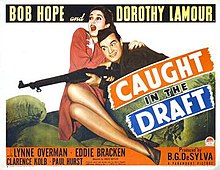
Road to Morocco is a 1942 American comedy film starring Bing Crosby, Bob Hope and Dorothy Lamour, and featuring Anthony Quinn and Dona Drake. Written by Frank Butler and Don Hartman and directed by David Butler, it’s the third of the "Road to ..." films. It was preceded by Road to Zanzibar (1941) and followed by Road to Utopia (1946). The story is about two fast-talking guys cast away on a desert shore and sold into slavery to a princess.
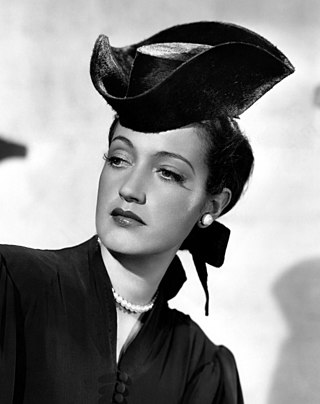
Dorothy Lamour was an American actress and singer. She is best remembered for having appeared in the Road to... movies, a series of successful comedies starring Bing Crosby and Bob Hope.

Duffy's Tavern is an American radio situation comedy that ran for a decade on several networks, concluding with the December 28, 1951, broadcast.
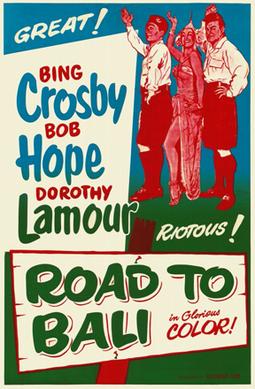
Road to Bali is a 1952 American comedy film directed by Hal Walker and starring Bing Crosby, Bob Hope, and Dorothy Lamour. Released by Paramount Pictures on November 19, 1952, the film is the sixth of the seven Road to … movies. It was the only entry in the series filmed in Technicolor and was the first to feature surprise cameo appearances from other well-known stars of the day.
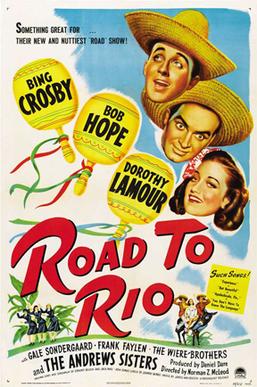
Road to Rio is a 1947 American semimusical comedy film directed by Norman Z. McLeod and starring Bing Crosby, Bob Hope, and Dorothy Lamour. Written by Edmund Beloin and Jack Rose, the film is about two inept vaudevillians who stow away on a Brazilian-bound ocean liner and foil a plot by a sinister hypnotist to marry off her niece to a greedy fortune hunter. Road to Rio was the fifth of the "Road to …" series.
"Tangerine" is a popular song. The music was written by Victor Schertzinger, the lyrics by Johnny Mercer. The song was published in 1941 and soon became a jazz standard.
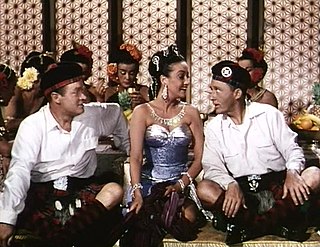
Road to ... is a series of seven comedy films starring Bing Crosby, Bob Hope, and Dorothy Lamour. They are also often referred to as the "Road" pictures or the "Road" series. The movies were a combination of adventure, comedy, romance, and music. The minimal plot often took a back seat to gags, which appeared improvised but were usually scripted.
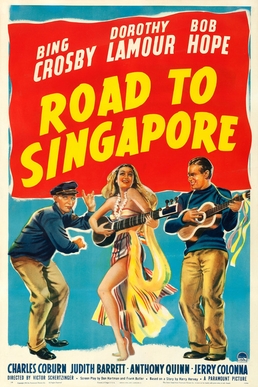
Road to Singapore is a 1940 American semi-musical comedy film directed by Victor Schertzinger and starring Bing Crosby, Dorothy Lamour and Bob Hope. Based on a story by Harry Hervey, the film is about two playboys trying to forget previous romances in British Singapore, where they meet a beautiful woman. Distributed by Paramount Pictures, the film marked the debut of the long-running and popular "Road to ..." series of pictures spotlighting the trio, seven in all. The supporting cast features Charles Coburn, Anthony Quinn, and Jerry Colonna.

Road to Zanzibar is a 1941 Paramount Pictures semi-musical comedy film starring Bing Crosby, Bob Hope, and Dorothy Lamour, and marked the second of seven pictures in the popular "Road to …" series made by the trio. It takes place in the Sultanate of Zanzibar.

Variety Girl is a 1947 American musical comedy film directed by George Marshall and starring Mary Hatcher, Olga San Juan, DeForest Kelley, Frank Ferguson, Glenn Tryon, Nella Walker, Torben Meyer, Jack Norton, and William Demarest. It was produced by Paramount Pictures. Numerous Paramount contract players and directors make cameos or perform songs, with particularly large amounts of screen time featuring Bing Crosby and Bob Hope. Among many others, the studio contract players include Gary Cooper, Alan Ladd, Paulette Goddard, Ray Milland, William Holden, Burt Lancaster, Robert Preston, Veronica Lake, William Bendix, Barbara Stanwyck and Paula Raymond.
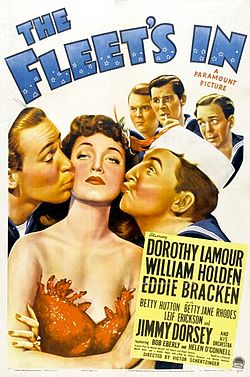
The Fleet's In is a 1942 movie musical produced by Paramount Pictures, directed by Victor Schertzinger, and starring Dorothy Lamour and William Holden. Although sharing the title of the 1928 Paramount film starring Clara Bow and Jack Oakie, it was not a remake. It was actually the second film version of the 1933 Kenyon Nicholson–Charles Robinson stage play Sailor, Beware!, enlivened with songs by Schertzinger and lyricist Johnny Mercer. The score, under the musical direction of Victor Young, includes the popular hits "Tangerine", and "I Remember You".
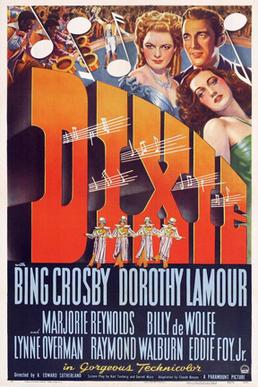
Dixie is a 1943 American biographical film of songwriter Daniel Decatur Emmett directed by A. Edward Sutherland and starring Bing Crosby and Dorothy Lamour. Filming in Technicolor, Dixie was only a moderate success and received mixed reviews. Contrary to rumor, it has not been withdrawn from circulation due to racial issues but is simply one of hundreds of vintage Paramount Pictures from the 1930s and 1940s now owned by Universal and not actively marketed; it was broadcast several times in the late 1980s on the American Movie Classics channel. The film produced one of Crosby's most popular songs, "Sunday, Monday, or Always".

Star Spangled Rhythm is a 1942 American all-star cast musical film made by Paramount Pictures during World War II as a morale booster. Many of the Hollywood studios produced such films during the war, generally musicals, frequently with flimsy storylines, and with the specific intent of entertaining the troops overseas and civilians back home and to encourage fundraising – as well as to show the studios' patriotism. This film was also the first released by Paramount to be shown for 8 weeks.
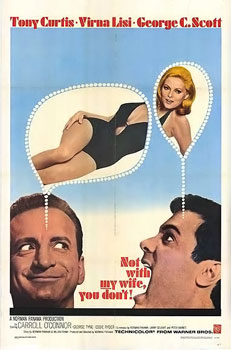
Not with My Wife, You Don't! is a 1966 American comedy film starred by Tony Curtis, Virna Lisi and George C. Scott. The film was nominated for a Golden Globe for Best Motion Picture – Musical/Comedy. The plot follows the standard storyline of the long-running "road movies" popularized by Bob Hope, Bing Crosby and Dorothy Lamour, also products of the Norman Panama-Melvin Frank writing team.

This is a selection of films and television appearances by British-American comedian and actor Bob Hope (1903-2003). Hope, a former boxer, began his acting career in 1925 in various vaudeville acts and stage performances

They Got Me Covered is a 1943 American comedy thriller film directed by David Butler and starring Bob Hope and Dorothy Lamour. Otto Preminger appears in a supporting role. It also known by the alternative titles Washington Story and The Washington Angle.

Hold That Blonde is a 1945 American comedy crime film directed by George Marshall and starring Eddie Bracken, Veronica Lake and Albert Dekker.
Hal Walker was an American film director. He was known for doing some of the earliest Dean Martin and Jerry Lewis films such as At War with the Army and Sailor Beware and some with the team of Bing Crosby and Bob Hope, directing Road to Utopia and Road to Bali.
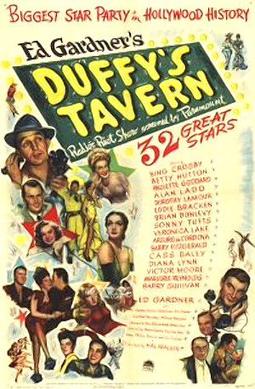
Duffy's Tavern is a 1945 American comedy film directed by Hal Walker and written by Melvin Frank and Norman Panama. The film stars Ed Gardner, Bing Crosby, Betty Hutton, Paulette Goddard, Alan Ladd, Dorothy Lamour, Eddie Bracken and Brian Donlevy. The film was released on September 28, 1945, by Paramount Pictures.
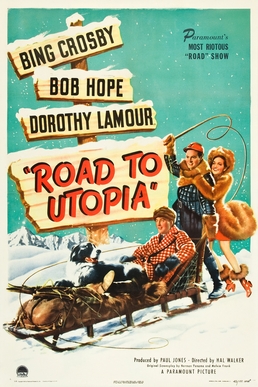
Road to Utopia is a 1946 American semi-musical comedy film directed by Hal Walker and starring Bing Crosby, Bob Hope, and Dorothy Lamour. Filmed in 1943 but not released until 1946, Road to Utopia is the fourth film of the "Road to ..." series. Written by Melvin Frank and Norman Panama, the film is about two vaudeville performers at the turn of the twentieth century who go to Alaska to make their fortune. Along the way they find a map to a secret gold mine. In 1947, Road to Utopia received an Academy Award nomination for Best Original Screenplay.
